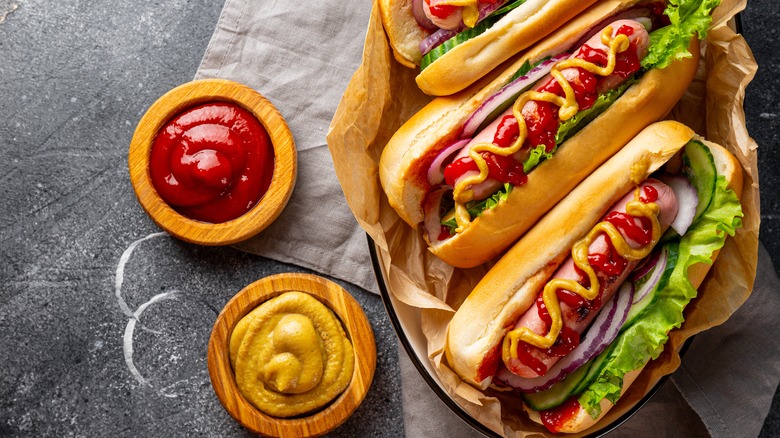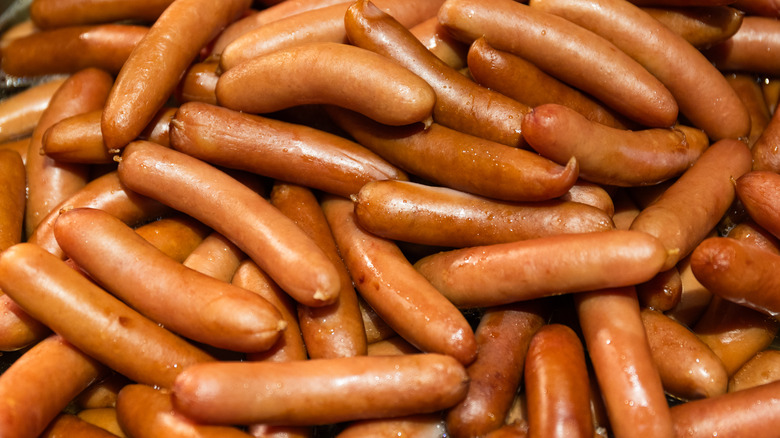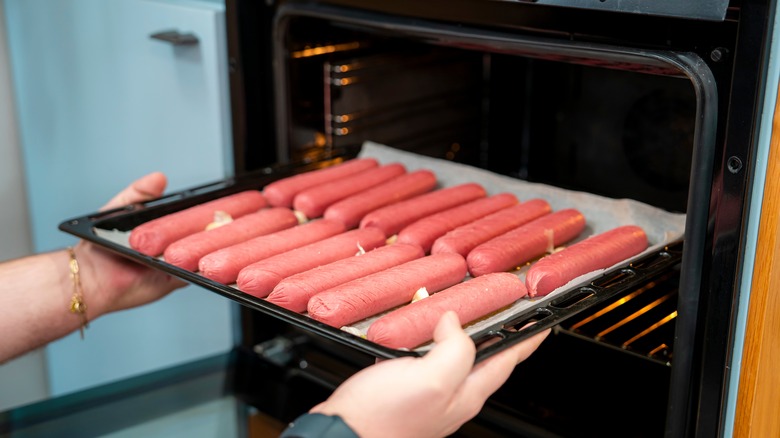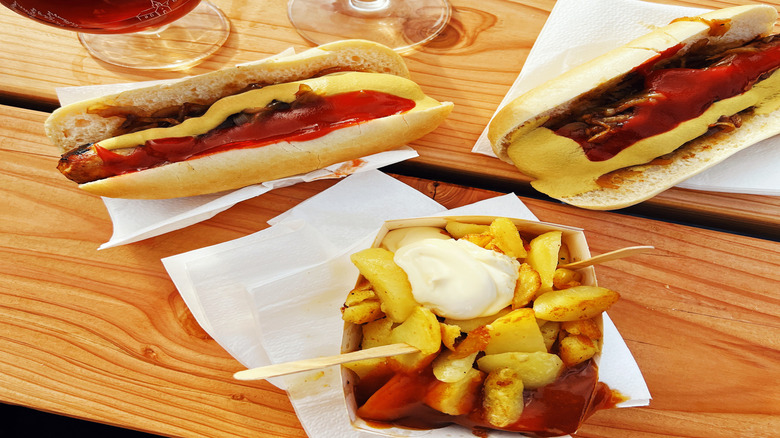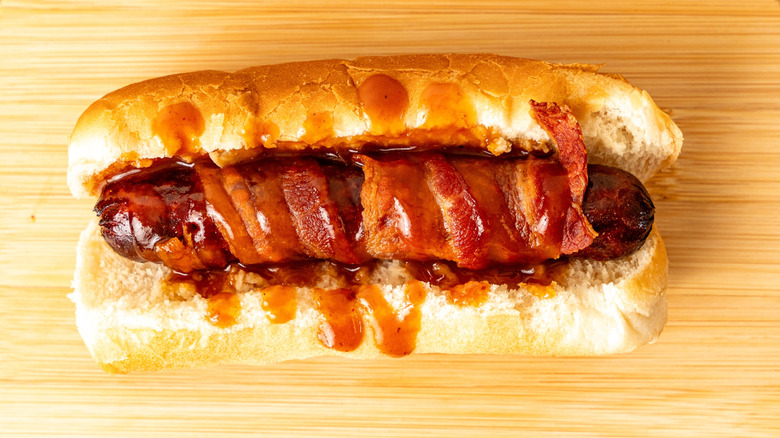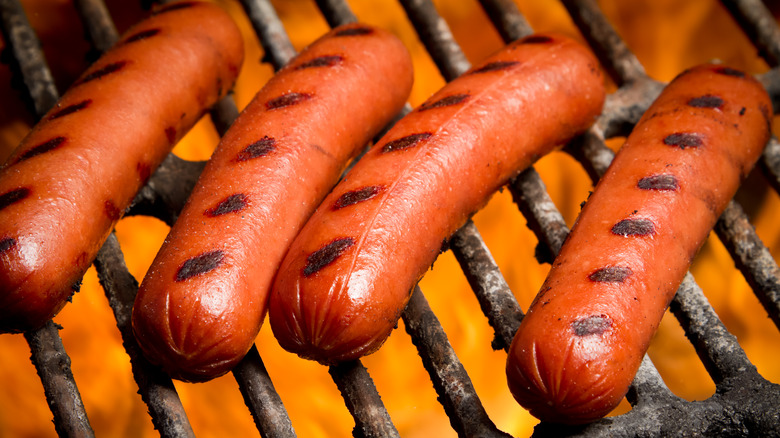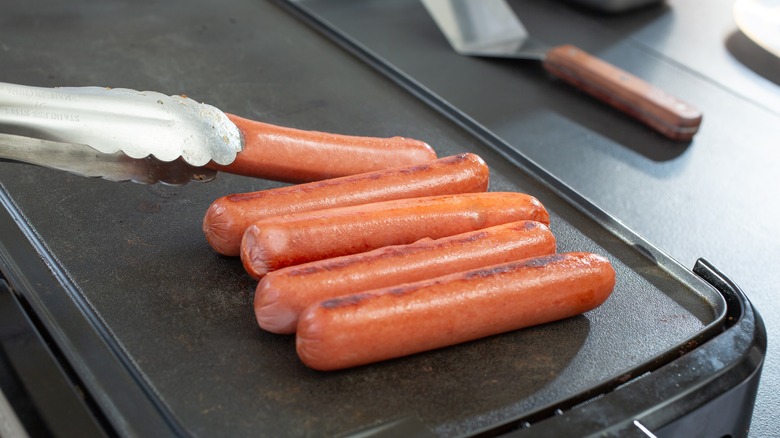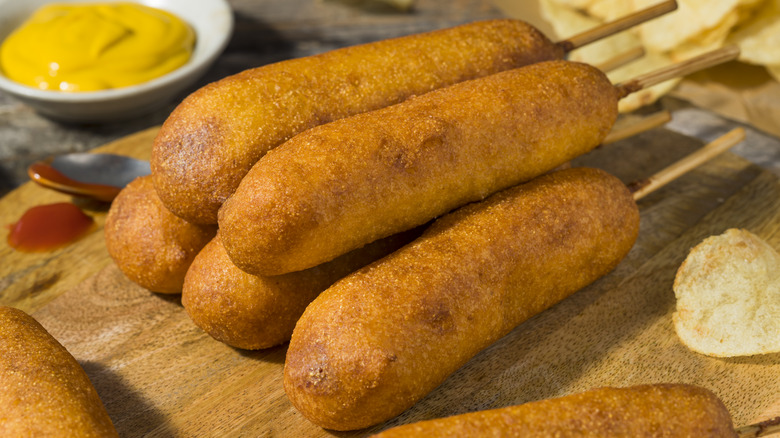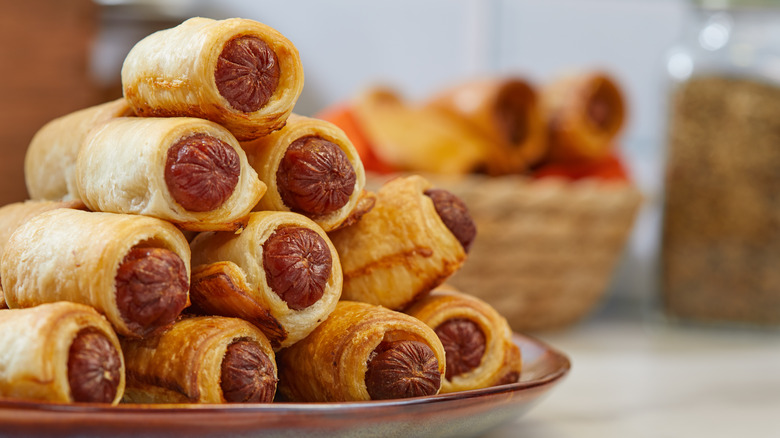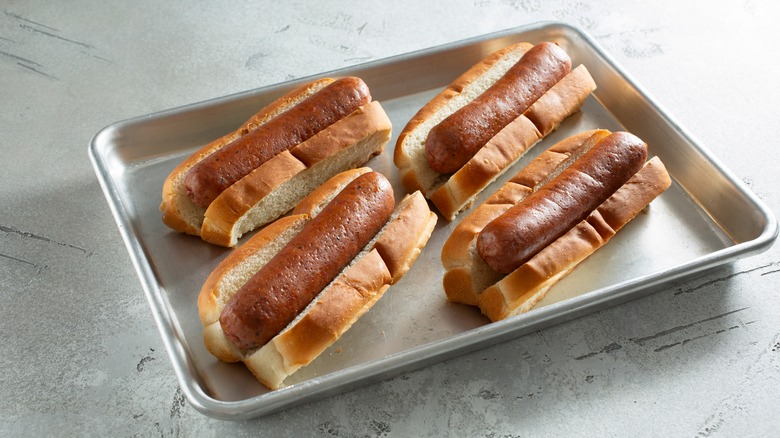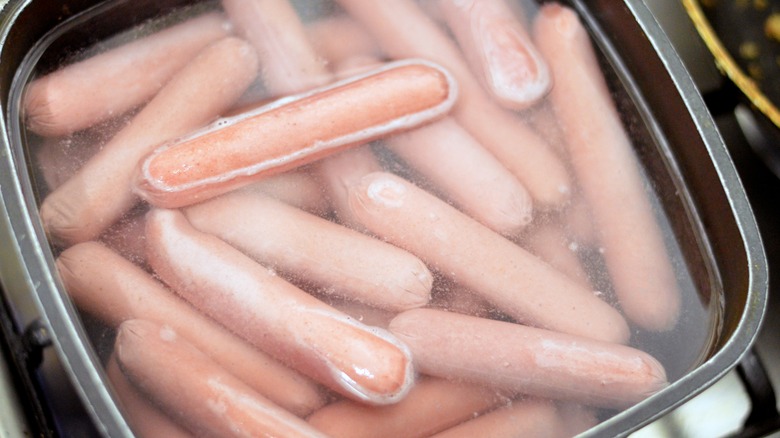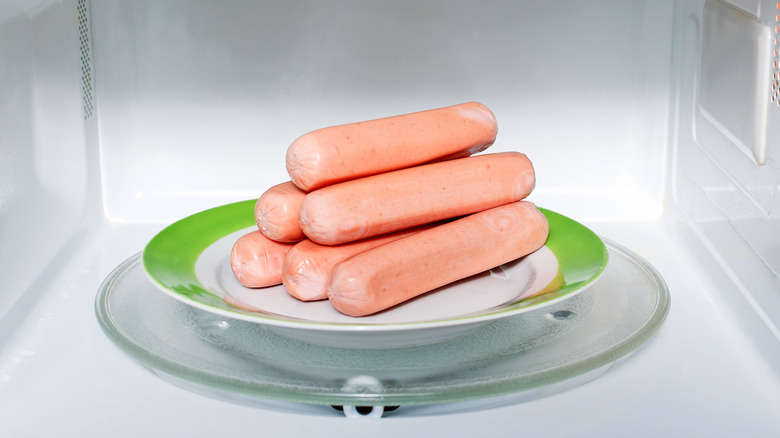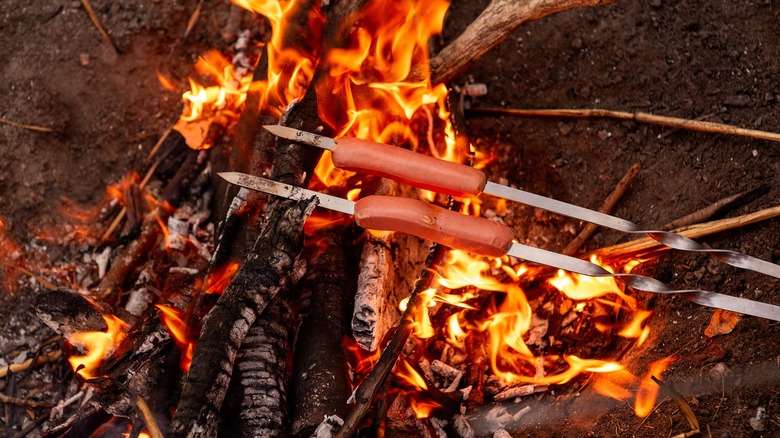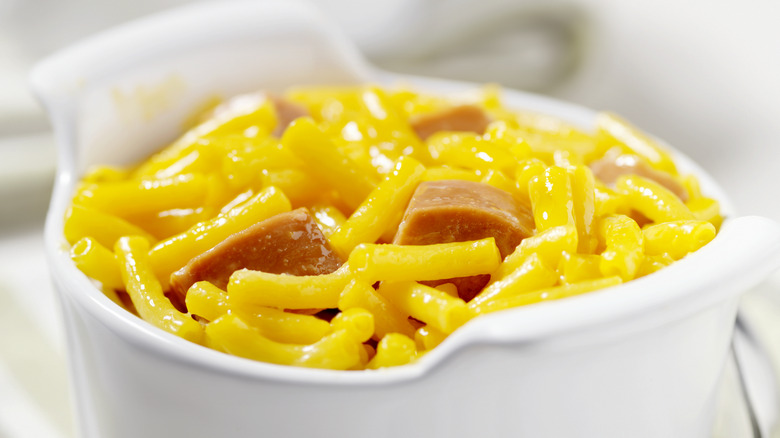8 Delicious Ways To Cook Hot Dogs And 6 Ways That You'll Regret
A juicy, savory frank encased in warm bread makes a perfect snack whether you're sitting poolside or tailgating. Yet, the hot dog is not a foolproof food; several cooking methods can compromise its taste or undermine its quality, saddling you with a lackluster link. It doesn't matter which regional hot dog style you're undertaking — no amount of toppings can save a poorly prepared frank.
Soggy hot dogs can dampen the spirits, while blackened ones can ruin the barbecue. Set yourself up for success by choosing the ideal preparation method for your favorite frankfurters. From Seattle-style hot dogs slathered in onions and cream cheese to New York–style ones topped with sauerkraut, mustard, and onion relish, cooking your hot dog correctly is a necessity. Be ready for the next cookout by knowing which methods to pursue and which to avoid.
Do: Toss them in the slow cooker for large gatherings
Although this method is one of the longest, taking up to four hours, it produces exceptional results in terms of flavor and coloring. Slow-cooked hot dogs harbor a deeply savory taste that isn't overly salty and a beautiful, browned exterior. To cook hot dogs in a slow cooker, you simply need to nestle them in, standing them upright to fit the most links, and cook them for two hours on high or four hours on low. You do not need to add any water; they will cook plenty fine on their own.
Considering how many hot dogs can fit in most crock pots, this is a superb method for those feeding large groups like neighborhood block parties. A 6-quart slow cooker can hold about 64 standard, 6 inch–long hot dogs. Even if you prefer another preparation method, a slow cooker is a great way to keep hot dogs warm until you're ready to eat them. Simply leave your slow cooker on the warm setting and store your ready-to-eat links inside.
Do: Broil links for a crispy texture
For those short on time, reach for the broiler in lieu of the microwave. A quick, four-minute foray above your oven's broiler will lead to luscious, fleshy interiors encased within a crisp surface. Broiling hot dogs is a spectacular method, be you cooking a couple links or enough to feed a party. Most recipes will recommend you place your broiler tray in the highest position you can and preheat the broiler on high. Once ready, broil for less than five minutes, removing the dogs as soon as you see a nice char. If desired, you can turn the links to brown the dogs on each side.
Hot dogs can also be broiled in a convection oven for an equally crispy yet juicy result. Just be sure to adjust the oven rack so that it's six inches away from the heat surface (which is usually on the top) to avoid scorching your franks.
Do: Braise or boil hot dogs in beer
For those that prefer a more tender, less crisped frank, consider boiling hot dogs in beer to bestow them with a plump, flavorful nature. Simmering hot dogs in beer will yield one of the mellowest, most highly flavored dogs you can craft. The beer you select doesn't need to be fancy, either. Most find a nice lager will give the dogs just enough oomph without bestowing any bitterness that an overly hoppy IPA might.
For an even better result, consider beer-braising your franks to soak them in even more flavor, adding hot dog toppings like onions or peppers in with the brew for an even richer bite. Adding brown sugar to the beer braise can sweeten the deal even more, leaving you with an excellent frank for topping with sauerkraut. Best of all, this method only takes 10 to 15 minutes, making it a great way to whip up a few franks whenever needed.
Do: Make use of your air fryer
Those who hanker for rotisserie-style hot dogs will salivate over those prepared in an air fryer. Air fryer hot dogs resemble the ones on rotating racks in all their gleaming, golden glory. Using an air fryer takes only four or five minutes. The franks cook speedily as the hot air inside fans around your links, crisping the outside while keeping the inside moist.
Some even argue cooking hot dogs in an air fryer is superior to grilling, taking less time and requiring no hubbub. One of the plus sides of using an air fryer for preparing hot dogs is that this method requires no demanding prep work and leaves you with minor cleanup. Looking to up your hot dog game? Try wrapping franks in bacon first for even more salty goodness. Air fryers are ideal for bacon-furled hot dogs since the circulating air cooks the bacon more equally than on a grill. Finish up by toasting your buns in the air fryer during the last two minutes for a delicious result.
Do: Grill them on the barbecue for a nice char
Perhaps the most classic of all cooking methods, the grill has long been considered the premier preparation for this timeless American eatable. Grilled hot dogs possess the signature snap that so many adore, succeeded by mouthwatering bites of juicy meat. Those who love franks infused with plenty of smokiness will relish this tried-and-true method — just be sure not to overcook those links. A little char is pleasant, but blackened or blistered hot dogs are not. Steer clear of other common mishaps when grilling hot dogs, such as leaving the dogs in one position for too long and grilling the dogs at too high a heat.
Butter and toast the buns on the grill for extra flavor, and be sure to season hot dogs before grilling. Many also recommend keeping one side of your grill hotter than the other, starting the franks on the cooler side to avoid overcooking the outsides, and then moving them to the hotter side toward the end of cooking. If you'd prefer not to use the two-zone heat method, remember to start your grill on hot, then lower the heat to medium for regular beef hot dogs. If your franks have a lower fat content, opt for medium-low.
Do: Griddle links if you don't have a grill
Sometimes grilling just isn't in the cards. On occasion, the weather interferes. Other times, you realize too late that you're out of charcoal or propane. One mustn't fear when the barbecue is unavailable — a similar method is within grasp. When there's no grill in sight, consider trying a less-conventional approach and try griddling your hot dogs for a remarkable result.
While juices might drip and drain away from grilled hot dogs leaving them drier, they won't on a flat-top griddle. Griddling can provide hot dogs with a wonderful sear without losing as much moisture as a grill. For this reason, some chefs prefer this method over grilling. Using a cast-iron griddle is best, but those that are aluminum-coated are also perfectly acceptable. Once heated, you can griddle your hot dogs in butter, vegetable oil, or lard. This is a great method when you're trapped inside due to rain or snow or when you're camping without a grill.
Do: Fry those puppies
Whether you're looking to bust out your deep fryer or fry franks in a pot on the stovetop, deep-fried hot dogs are a noteworthy invention. Consider the ripper hot dog: Born in New Jersey at Rutt's Hut, this frank is fried in a deep fryer until it bursts, turning it into a crispy, meaty delight with a distinguishing bite.
Those unwilling to make the trip to the home of the ripper in Clifton, New Jersey, can mimic the process at home using an oiled up frying pan or deep fryer. Looking to up the crispy factor? Skewer those links and dip them in batter for homemade corn dogs that are sure to delight. You can craft a classic cornbread batter for some comforting carnival fare, or opt for beer batter for a less sweet hot dog on a stick; both are equally sensational choices.
Do: Wrap them in dough for pigs in a blanket
Looking to expand your hot dog horizons and ditch the bun entirely? Consider cloaking tender franks in swathes of bready goodness so you never have to worry about buying an equal number of buns and links again. Pigs in a blanket can be as simple or refined as you wish them to be. If you're short on ingredients, you can roll them between Pillsbury crescent rolls for an appetizer that's fantastic for dipping. Consider adding cheese and onions for additional savory flavor.
Looking for something more filling? Try swaddling hot dogs in pizza dough and embellishing them with chili. Hoping to impress your friends? Envelop your high-quality franks in flaky layers of puff pastry or phyllo dough. Add accoutrements like a dollop of Dijon mustard, everything seasoning, or cream cheese and jalapeños. Whether you coil those piggies in puff pastry or pizza dough or simply roll them between store-bought crescent rolls, hot dogs in warm, buttery bread are hard to beat.
Don't: Dry out franks in the oven
A frequent alternative often reached for when catering to a crowd is oven-baking, seeing how one can pack a vast amount of hot dogs in the oven. The catch? You'll be choosing quantity over quality. Oven-baked hot dogs have a tendency to dry out, rendering their casings chewier and almost jerky-like. Critics of the oven-baked method also attest that hot dogs heated in the oven seem extra salty, as their flavors become intensified resulting from the moisture loss. Yes, you can fit many links on a sheet pan, but these dogs just won't have the same quality as other methods.
If, for some reason, the oven is your only cooking option, consider wrapping your entire hot dog — buns, toppings, and all — in foil and baking it at 350 F for 30 minutes. This will hold in the moisture, preventing the franks from dehydrating.
Don't: Boil hot dogs in water
Often the most frowned-upon of all the preparation methods, boiling hot dogs in water should be avoided at all costs. While it's one of the only methods to prepare frozen hot dogs, it lacks in savoriness what it delivers in convenience. Bubbling hot dogs away in a pot of plain water will result in flavor loss as the frank's meatiness disperses out into the surrounding water, leaving you with a plump and bland hot dog. Even worse, boiled hot dogs bear a dull appearance, looking pinkish-gray. Texture-wise, you'll find them lacking the distinctive hot dog snap desired by many, instead providing a softer bite along with their subdued flavor.
If you're dead set on boiling your hot dogs, you'd be wise to swap out the water for a richer liquid. Beer is best, but simmering hot dogs in chicken or beef broth will also provide more flavor than plain old tap water. Even the addition of a bouillon cube will do wonders. Cooking a meatless hot dog? Vegetable broth may be used for vegan franks!
Don't: Subject your links to the microwave
If the squealing, screaming sounds of a hot dog in the microwave aren't enough to deter you, consider the possible disasters that might occur. Hot dogs remain firmly in the do not microwave category due to their unpredictable nature. Round items or those with skin are especially prone to exploding — hot dogs are unfortunately both. Microwaved hot dogs can explode due to trapped steam beneath their skin-like casing. Yes, you can spear or slice a hot dog to vent the steam, but doing so will dry your hot dog out and leave it rubbery.
Even if they doesn't explode, microwaved hot dogs are prone to uneven cooking, with some portions overcooked and others undercooked. You'll likely find your frank spoiled by dehydrated ends and a chewy texture. Like any lunch meat, it's best to skip the microwave when it comes to hot dogs, electing for a safer and tastier means of preparation.
Don't: Blacken franks over a campfire
It might come as a surprise that cooking a hot dog over an open flame is never recommended, as it will most certainly result in burned franks. Although the image of speared hot dogs on sticks roasting over a summer campfire is appealing to many, this cooking method poses multiple challenges. Not only is it difficult to control the heat over a live flame (leading to uneven cooking), smoke inhalation poses a potential threat. When you're burning wood, the resulting smoke can harbor tiny particles that can irritate or harm the lungs. This is why you should always be mindful of where your campfire smoke is blowing, and move accordingly — something that's harder to do when you're diligently focused on not burning your hot dog.
Furthermore, you're more likely to overcook your hot dogs over a fire due to carryover cook time. Carryover cooking time (the time that a food continues to cook after being removed from heat) will be longer when you're cooking over on open flame. Although you might remove those dogs as they hit your preferred doneness, they'll keep cooking off the fire. This also means you'll have to wait longer for those hot dogs to cool off in order to avoid a scalding bite. If you must cook your hot dogs over the fire, always wait until the fire has died down and mostly coals are left to prevent burned links. The embers will also emit less smoke.
Don't: Steam and pan-fry links
Although steaming and pan-frying hot dogs sounds like a good idea, it rarely is. Proponents of this method argue that the steaming delivers a plump dog while the pan-searing provides an appealing, golden exterior. You may think that steaming followed by a quick pan sear would lead to the best of both worlds, franks subjected to this technique will be underwhelming when compared to other methods.
Steaming your links first does nothing to make the dogs any more juicy than regular pan-frying, and the result lacks the appetizing browned exterior many other methods provide. Some also find the taste to be more watered down. It's best to skip the pan altogether when it comes to hot dogs. Other methods will ensure a meatier, more flavorful hot dog worthy of whatever toppings you plan to grace it with.
Don't: Bury them in a casserole
Hot dogs should be portable and eaten single-handedly, requiring no knives, forks, or spoons — even if they're covered in chili. Don't relegate your hot dogs to the background by burying them beneath mounds of cheese or pasta. Let them shine at the forefront in all their nostalgic simplicity. Hot dog casserole sounds like something that ought to be served in a school cafeteria, not someone's home.
However, to those truly mesmerized by the idea of mashed potatoes draped by hot dogs or franks sliced into mac and cheese, no one will burst into your kitchen and stop you. If hot dog casserole holds a special place in your heart, go for it. But, more creative alternatives exist.
If you're looking to add more flavor to hot dogs or try a new take on the classic style, allow yourself to be inspired by regional or international incarnations of the hot dog, instead. Experience a Windy City icon and sample a Chicago-style hot dog, packed with sweet pickle relish, chopped onion, pickles, and tomatoes. Enjoy a Brazilian hot dog cooked in tomato sauce and heaped sky-high with toppings from potato sticks to corn. There are countless ways to reinvent the hot dog that will keep your casserole dish safely out of the picture.

